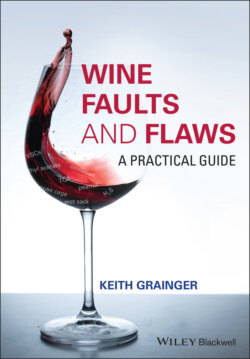Читать книгу Wine Faults and Flaws - Keith Grainger - Страница 97
References
Оглавление1 1 Tempere, S., Cuzange, E., Bougeant, J.C. et al. (2012). Explicit sensory training improves the olfactory sensitivity of wine experts. Chemosensory Perception 5: 205–213. https://doi.org/10.1007/s12078-012-9120-1.
2 2 Kaeppler, K. and Mueller, F. (2013). Odor classification: a review of factors influencing perception‐based odor arrangements. Chemical Senses 38 (3): 189–209. https://doi.org/10.1093/chemse/bjs141.
3 3 Grainger, K. and Tattersall, H. (2016). Wine Production and Quality, 2e. Chichester: Wiley Blackwell.
4 4 ISO 8586/2012 (2012). General guidelines for the selection, training and monitoring of selected assessors and expert sensory assessors. Geneva: International Organization for Standardization.
5 5 ISO 8589:2007 (2007). Sensory analysis — General guidance for the design of test rooms. Geneva: The International Organization for Standardization.
6 6 ISO 3591:1977 (1977). Sensory analysis – Apparatus – Wine‐tasting glass. Geneva: The International Organization for Standardization.
7 7 International Organisation of Vine and Wine (OIV) (2015). Review Document on Sensory Analysis of Wine. Paris: OIV. http://www.oiv.int/public/medias/3307/review-on-sensory-analysis-of-wine.pdf.
8 8 Lin, J., Massonnet, M., and Cantu, D. (2019). The genetic basis of grape and wine aroma. Horticulture Research 6 (81) https://doi.org/10.1038/s41438-019-0163-1.
9 9 Ugliano, M. (2013). Oxygen contribution to wine aroma evolution during bottle aging. Journal of Agricultural and Food Chemistry 61 (26): 6125–6136. https://doi.org/10.1021/jf400810v.
10 10 Coetzee, C. and du Toit, W.J. (2012). A comprehensive review on Sauvignon Blancaroma with a focus on certain positive volatile thiols. Food Research International 45 (1): 287–298. https://doi.org/10.1016/j.foodres.2011.09.017.
11 11 Malik, B., Elkaddi, N., Turkistani, J. et al. (2021). Mammalian taste cells express functional olfactory receptors. Chemical Senses 44 (5): 289–301. https://doi.org/10.1093/chemse/bjz019.
12 12 International Organisation of Vine and Wine (OIV) (2019). International Oenological Codex. Paris: OIV. http://www.oiv.int/public/medias/6550/codex-2019-en.pdf https://www.oiv.int/public/medias/7790/codex‐2021‐en.pdf
13 13 Noble, A.C. (1998). Why do wines taste bitter and feel astringent? In: Chemistry of Wine Flavour (eds. A.L. Waterhouse and S.E. Ebeler), 156–165. Washington, DC: American Chemical Society.
14 14 Rankine, B. (1989). Making Good Wine. Sydney: Macmillan Australia.
15 15 Matthews, M.A. (2015). Terroir and Other Myths of Winegrowing. Oakland: University of California Press.
